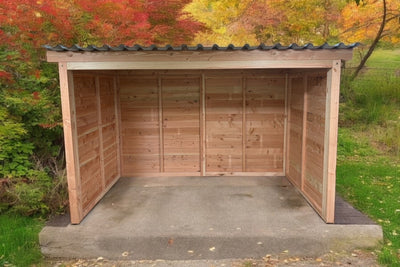Build your own hedgehog houses - create winter quarters for hedgehogs in Switzerland
When the days get shorter again and the temperatures drop in the fall, a critical phase begins for hedgehogs in Switzerland: the search for suitable winter quarters. However, many Swiss gardens are increasingly lacking natural shelters such as hedges, open compost heaps or quiet piles of leaves. At the same time, there is a growing awareness among garden owners to actively support wildlife - not least because such initiatives also bring children closer to nature and teach them to treat it with respect.
A carefully planned hedgehog house can help these prickly garden dwellers survive the winter - and help preserve their ecological role in the garden. In this article, you will find out why winter shelters are so important for hedgehogs, which materials are best suited to Swiss gardens, how to build a safe hedgehog house yourself and what you should bear in mind when choosing a location and caring for it. We also show you how to use sustainable materials and avoid common mistakes.
Why are winter shelters important for hedgehogs?

The role of hedgehogs in the garden ecosystem
Hedgehogs are valued helpers in natural gardens. They prefer to feed on snails, insect larvae and beetles - and thus reduce pest pressure in a natural way. Especially in Swiss private gardens with diverse planting, hedgehogs help to maintain the ecological balance and often make chemical pesticides superfluous.
Brown-breasted hedgehogs (Erinaceus europaeus) are widespread in Switzerland, but have been under pressure for years. They are increasingly losing their natural habitats due to soil sealing, intensive lawn care and dense fencing. The garden is thus becoming an important protection zone for these endangered native wild animals.
Dangers and challenges in the cold season
Hedgehogs need dry, frost-proof and quiet hiding places to hibernate. In modern gardens, however, these structures are often missing: leaves are removed, wood is tidied up, the garden is winterized - unfortunately usually at the expense of wildlife. In addition, cold, damp and predators such as martens or foxes make it difficult for hedgehogs to survive without a sheltered retreat.
Young animals in particular, which have not yet gained enough weight in the fall, benefit from human support. You can therefore contribute directly to the preservation of the hedgehog population with a prepared winter habitat - quite simply in your own garden.
What materials and locations are suitable for a hedgehog shelter?
Recommended materials for hedgehog houses
Only natural and pollutant-free materials are suitable for building a species-appropriate hedgehog house in the Swiss garden. These are particularly suitable:
- Untreated hardwood such as larch or oak - durable, insulating and robust against the weather.
- Clay roof tiles or bricks as a covering material - they ensure breathability and moisture regulation.
- Leaves, hay or straw for the interior - these provide padding and heat storage, similar to natural nests.
Painted or impregnated wood, plastic, chipboard and metal are unsuitable. These can release harmful substances or promote condensation, which can lead to mold in the interior.
The right location in the garden
A safe hedgehog house should be placed in a quiet, semi-shady location - preferably under a hedge, next to a pile of leaves or in a natural corner of the garden. Slightly raised, well-drained soil without waterlogging is ideal.
- Sheltered position: Avoid exposed places with direct sunlight or wind.
- Distance from paths: Place the house at least several meters away from heavily frequented garden paths.
- Cover: Use loosely layered branches or a protective tarpaulin to create additional weather protection.
Recommendation: Place two or three roosts in different places. This increases the chance that at least one will be accepted - especially in larger gardens or near-natural areas.
How do I plan the size and construction of a hedgehog-friendly winter roost?
Customization and safety in the family garden
An ideal hedgehog house in Switzerland measures approx. 30-40 cm in width, 30 cm in depth and around 25-30 cm in height. The entrance should be around 10 x 10 cm so that the hedgehog can get in easily, but larger animals should stay outside.
In family gardens in particular, it is advisable to position the nest in such a way that small children do not accidentally disturb it - e.g. with a privacy screen or cleverly placed under shrubs. Integrate the project together with your children: Building a hedgehog house is a meaningful fall project with a learning effect for young and old.
Step-by-step instructions for do-it-yourself construction
With a little skill, you can easily build a hedgehog house yourself - ideally suited to the needs of your Swiss garden:
- Saw five boards from approx. 1.5-2 cm thick untreated solid wood (sides, base, lid).
- Cut or mill the entrance hole of approx. 10 cm diameter into the front side.
- Assemble the parts using weatherproof screws.
- Fill the inside with dry leaves, hay or straw.
- Cover the roof with tiles or a waterproof tarpaulin and weigh it down lightly.
Note: Alternatively, you can buy robust hedgehog houses from regional suppliers in Switzerland, for example from Wildtierhilfe Schweiz or via Lubex Natura. Look out for ecological materials and workmanship.
Sustainability and quality: Why is this important for hedgehog shelters?
Advantages of natural materials
A hedgehog house made from biodegradable, untreated materials not only meets ecological standards, but also ensures an ideal microclimate inside. Wood breathes, regulates humidity and prevents the formation of condensation - which prevents mold growth and disease.
In addition, many hedgehogs more easily recognize natural materials as shelter. In practice, leaves, straw and wooden structures are therefore much more frequently accepted than plastic boxes or concrete solutions.
Care and longevity are worthwhile
A high-quality hedgehog shelter made of larch wood can easily survive several winters, provided it is regularly maintained:
- Spring (from March): Clean the nest with gloves, remove leaves and any debris, rinse with hot water and allow to dry thoroughly.
- Summer: Either store in a sheltered place or leave in the garden as a daytime hiding place.
- Fall (September/October): Fill with new dry leaves or hay and place in the predetermined location.
Regular checks for pest infestation and moisture extend the lifespan and ensure the animals are protected.
Avoid common mistakes when building and maintaining hedgehog shelters
Recognize typical tripping hazards
Even well-intentioned hedgehog shelters sometimes remain unused - this is often due to construction or installation errors. The most common mistakes are
- Incorrect materials: Plywood, treated wood or plastic lead to odor and moisture - and are avoided.
- Large entrance: Openings larger than 12 cm invite cats, rats or other unwanted visitors in.
- Proximity to humans: Hedgehogs avoid close proximity to patios, garden lamps or playgrounds.
- Too frequent checks in winter: A hedgehog house should not be moved or opened during hibernation.
Another mistake is the combination with feeders: These attract moisture and increase the risk of parasites. You should therefore feed hedgehogs separately - only until the first frost and in a dry, cat-proof place.
How much does a hedgehog house cost - and is it worth it?
A simple self-built hedgehog house costs between CHF 20 and CHF 50, depending on the materials used. If you use recycled wood, you can build a much cheaper house. Well-made prefabricated houses from Swiss specialist retailers usually cost between CHF 60 and CHF 150 - but you save time and get a tested solution.
The purchase is worthwhile in the long term: a hedgehog house that can be used for many years promotes local biodiversity and reduces the need for pest control. The biggest expense is not the price - but the planning, choice of location and maintenance.
Conclusion: Small help, big impact - supporting hedgehogs in the Swiss garden
A species-appropriate hedgehog house is an uncomplicated and efficient way to help endangered wild animals in your own garden. With just a few materials, a little time and careful planning, you can make a direct contribution to preserving native biodiversity.
Whether as a DIY project with the family or as a ready-made solution from a specialist retailer, now is the right time to get active. Observe your garden, choose a quiet spot with a natural character - and offer your prickly guests a safe home for the winter.
Start a garden project now - your measure for more biodiversity in Swiss gardens!


